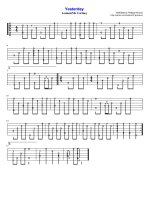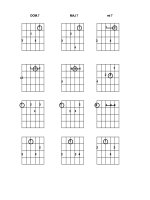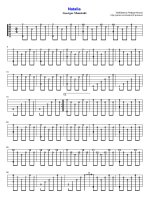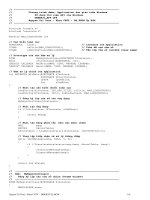Session 10 XP tủ tài liệu bách khoa
Bạn đang xem bản rút gọn của tài liệu. Xem và tải ngay bản đầy đủ của tài liệu tại đây (2.63 MB, 46 trang )
Fundamentals of Java
Describe inheritance
Explain the types of inheritance
Explain super class and subclass
Explain the use of super keyword
Explain method overriding
Describe Polymorphism
Differentiate type of reference and type of objects
Explain static and dynamic binding
Explain virtual method invocation
Explain the use of abstract keyword
© Aptech Ltd.
Inheritance and Polymorphism/Session 10
2
In the world around us, there are many animals and birds that eat the same
type of food and have similar characteristics.
Therefore, all the animals that eat plants can be categorized as herbivores,
those that eat animals as carnivores, and those that eat both plants and
animals as omnivores.
This kind of grouping or classification of things is called subclassing and the
child groups are known as subclasses.
Similarly, Java provides the concept of inheritance for creating subclasses of a
particular class.
Also, animals such as chameleon change their color based on the
environment.
Human beings also play different roles in their daily life such as father, son,
husband, and so on.
This means, that they behave differently in different situations.
Similarly, Java provides a feature called polymorphism in which objects
behave differently based on the context in which they are used.
© Aptech Ltd.
Inheritance and Polymorphism/Session 10
3
In daily life, one often comes across objects that share a kind-of or is-a relationship
with each other.
For example, Car is-a four-wheeler, a four-wheeler is-a vehicle, and a vehicle is-a
machine.
Similarly, many other objects can be identified having such relationship. All such
objects have properties that are common.
For example, all four wheelers have wipers and a rear view mirror.
All vehicles have a vehicle number, wheels, and engine irrespective of a fourwheeler or two-wheeler.
Following figure shows some examples of is-a relationship:
© Aptech Ltd.
Inheritance and Polymorphism/Session 10
4
The figure shows is-a relationship between different objects.
For example, Deer is-a herbivore and a herbivore is-a animal.
The common properties of all herbivores can be stored in class herbivore.
Similarly, common properties of all types of animals such as herbivore,
carnivore, and omnivore can be stored in the Animal class.
Thus, the class Animal becomes the top-level class from which the other
classes such as Herbivore, Carnivore, and Omnivore inherit properties and
behavior.
The classes Deer, Horse, Lion, and so on inherit properties from the classes
Herbivore, Carnivore, and so on.
This is called inheritance.
Thus, inheritance in Java is a feature through which classes can be derived
from other classes and inherit fields and methods from those classes.
© Aptech Ltd.
Inheritance and Polymorphism/Session 10
5
The class that is derived from another class is called a subclass, derived class, child class, or
extended class.
The class from which the subclass is derived is called a super class, base class, or parent class.
The derived class can reuse the fields and methods of the existing class without having to
re-write or debug the code again.
A subclass inherits all the members such as fields, nested classes, and methods from its super
class except those with private access specifier.
Constructors of a class are not considered as members of a class and are not inherited by
subclasses.
The child class can invoke the constructor of the super class from its own constructor.
Members having default accessibility in the super class are not inherited by subclasses of
other packages.
The subclass will have its own specific characteristics along with those inherited from the
super class.
© Aptech Ltd.
Inheritance and Polymorphism/Session 10
6
There are several types of inheritance as shown in the following figure:
• A child class
inherits from
one and only
one parent class
• A parent class
has more than
one child classes
at different
levels
© Aptech Ltd.
• A child class
derives from a
parent that itself
is a child of
another class
Single
Inheritance
Multilevel
Inheritance
Hierarchical
Inheritance
Multiple
Inheritance
Inheritance and Polymorphism/Session 10
• A child class
derives from
more than one
parent class
7
Within a subclass, one can use the inherited members as is, hide them, replace them,
or enhance them with new members as follows:
The inherited members, including fields and methods, can be directly used just like
any other fields.
One can declare a field with the same name in the subclass as the one in the super
class. This will lead to hiding of super class field which is not advisable.
One can declare new fields in the subclass that are not present in the super class.
These members will be specific to the subclass.
One can write a new instance method with the same signature in the subclass as
the one in the super class. This is called method overriding.
A new static method can be created in the subclass with the same signature as
the one in the super class. This will lead to hiding of the super class method.
One can declare new methods in the subclass that are not present in the super
class.
A subclass constructor can be used to invoke the constructor of the super class,
either implicitly or by using the keyword super.
The extends keyword is used to create a subclass. A class can be directly derived
from only one class.
© Aptech Ltd.
Inheritance and Polymorphism/Session 10
8
If a class does not have any super class, it is implicitly derived from Object class.
The syntax for creating a subclass is as follows:
Syntax
public class <class1-name> extends <class2-name>
{
…
…
}
where,
class1-name: Specifies the name of the child class.
class2-name: Specifies the name of the parent class.
Following code snippet demonstrates the creation of super class Vehicle:
package session10;
public class Vehicle {
// Declare common attributes of a vehicle
protected String vehicleNo; // Variable to store vehicle number
protected String vehicleName; // Variable to store vehicle name
protected int wheels; // Variable to store number of wheels
© Aptech Ltd.
Inheritance and Polymorphism/Session 10
9
/**
* Accelerates the vehicle
*
* @return void
*/
public void accelerate(int speed) {
System.out.println(“Accelerating at:”+ speed + “ kmph”);
}
}
The parent class Vehicle consists of common attributes of a vehicle such as
vehicleNo, vehicleName, and wheels.
Also, it consists of a common behavior of a vehicle, that is, accelerate() that
prints the speed at which the vehicle is accelerating.
Following code snippet demonstrates the creation of subclass FourWheeler:
package session10;
class FourWheeler extends Vehicle{
// Declare a field specific to child class
private boolean powerSteer; // Variable to store steering information
© Aptech Ltd.
Inheritance and Polymorphism/Session 10
10
/**
* Parameterized constructor to initialize values based on user input
*
* @param vID a String variable storing vehicle ID
* @param vName a String variable storing vehicle name
* @param numWheels an integer variable storing number of wheels
* @param pSteer a String variable storing steering information
*/
public FourWheeler(String vId, String vName, int numWheels, boolean
pSteer){
// Attributes inherited from parent class
vehicleNo = vId;
vehicleName = vName;
wheels = numWheels;
// Child class’ own attribute
powerSteer = pSteer;
}
© Aptech Ltd.
Inheritance and Polymorphism/Session 10
11
/**
* Displays vehicle details
*
* @return void
*/
public void showDetails() {
System.out.println(“Vehicle no:”+ vehicleNo);
System.out.println(“Vehicle Name:”+ vehicleName);
System.out.println(“Number of Wheels:”+ wheels);
if(powerSteer == true)
System.out.println(“Power Steering:Yes”);
else
System.out.println(“Power Steering:No”);
}
}
/**
* Define the TestVehicle.java class
*/
public class TestVehicle {
© Aptech Ltd.
Inheritance and Polymorphism/Session 10
12
/**
* @param args the command line arguments
*/
public static void main(String[] args) {
// Create an object of child class and specify the values
FourWheeler objFour = new FourWheeler(“LA-09 CS-1406”, “Volkswagen”,
4, true);
objFour.showDetails(); // Invoke the child class method
objFour.accelerate(200); // Invoke the inherited method
}
}
Following figure shows the output of the program:
© Aptech Ltd.
Inheritance and Polymorphism/Session 10
13
Java allows creation of an instance method in a subclass having the same signature
and return type as an instance method of the super class.
This is called method overriding.
Method overriding allows a class to inherit behavior from a super class and then, to
modify the behavior as needed.
Rules to remember when overriding:
The overriding method must have the same name, type, and number of
arguments as well as return type as the super class method.
An overriding method cannot have a weaker access specifier than the access
specifier of the super class method.
The accelerate() method can be overridden in the subclass as shown in the
following code snippet:
package session10;
class FourWheeler extends Vehicle{
// Declare a field specific to child class
private boolean powerSteer; // Variable to store steering information
© Aptech Ltd.
Inheritance and Polymorphism/Session 10
14
/**
* Parameterized constructor to initialize values based on user input
*
* @param vID a String variable storing vehicle ID
* @param vName a String variable storing vehicle name
* @param numWheels an integer variable storing number of wheels
* @param pSteer a String variable storing steering information
*/
public FourWheeler(String vId, String vName, int numWheels, boolean
pSteer){
// attributes inherited from parent class
vehicleNo=vId;
vehicleName=vName;
wheels=numWheels;
// child class’ own attribute
powerSteer=pSteer;
}
© Aptech Ltd.
Inheritance and Polymorphism/Session 10
15
/**
* Displays vehicle details
*
* @return void
*/
public void showDetails() {
System.out.println(“Vehicle no:”+ vehicleNo);
System.out.println(“Vehicle Name:”+ vehicleName);
System.out.println(“Number of Wheels:”+ wheels);
if(powerSteer==true){
System.out.println(“Power Steering:Yes”);
else
System.out.println(“Power Steering:No”);
}
/**
* Overridden method
* Accelerates the vehicle
*
* @return void
© Aptech Ltd.
Inheritance and Polymorphism/Session 10
16
*/
@Override
public void accelerate(int speed) {
System.out.println(“Maximum acceleration:”+ speed + “ kmph”);
}
}
/**
* Define the TestVehicle.java class
*/
public class TestVehicle {
/**
* @param args the command line arguments
*/
public static void main(String[] args) {
// Create an object of child class and specify the values
FourWheeler objFour = new FourWheeler(“LA-09 CS-1406”, “Volkswagen”,
4, true);
objFour.showDetails(); // Invoke child class method
objFour.accelerate(200); // Invoke inherited method
}
}
© Aptech Ltd.
Inheritance and Polymorphism/Session 10
17
The accelerate() method is overridden in the child class with the same signature
and return type but with a modified message.
Notice the use of @Override annotation on top of the method.
Annotations provide additional information about a program. Annotations have
no direct effect on the functioning of the code they annotate.
Following figure shows the output of the code:
The accelerate() method now prints the message specified in the subclass.
Since the accelerate() method is overridden in the subclass, the subclass version
of the accelerate() method is invoked and not the super class accelerate()
method.
© Aptech Ltd.
Inheritance and Polymorphism/Session 10
18
In the code, the subclass constructor is used to initialize the values of the common
attributes inherited from the super class Vehicle.
This is not the correct approach because all the subclasses of the Vehicle class will
have to initialize the values of common attributes every time in their constructors.
Java allows the subclass to invoke the super class constructor and methods using the
keyword super.
Also, when the accelerate() method is overridden in the subclass, the
statement(s) written in the accelerate() method of the super class, Vehicle,
are not printed.
To address these issues, one can use:
the super keyword to invoke the super class method using
super.method-name().
the super() method to invoke the super class constructors from the subclass
constructors.
© Aptech Ltd.
Inheritance and Polymorphism/Session 10
19
Following code snippet demonstrates the modified super class Vehicle.java using
a parameterized constructor:
package session10;
class Vehicle {
protected String vehicleNo; // Variable to store vehicle number
protected String vehicleName; // Variable to store vehicle name
protected int wheels; // Variable to store number of wheels
/**
* Parameterized constructor to initialize values based on user input
*
* @param vId a String variable storing vehicle ID
* @param vName a String variable storing vehicle name
* @param numWheels an integer variable storing number of wheels
*/
public Vehicle(String vId, String vName, int numWheels){
vehicleNo=vId;
vehicleName=vName;
wheels=numWheels;
}
© Aptech Ltd.
Inheritance and Polymorphism/Session 10
20
/**
* Accelerates the vehicle
*
* @return void
*/
public void accelerate(int speed){
System.out.println(“Accelerating at:”+ speed + “ kmph”);
}
}
Following code snippet depicts the modified subclass FourWheeler.java using the
super keyword to invoke super class constructor and methods:
package session10;
class FourWheeler extends Vehicle{
private boolean powerSteer; // Variable to store steering information
/**
* Parameterized constructor to initialize values based on user input
*
* @param vID a String variable storing vehicle ID
* @param vName a String variable storing vehicle name
* @param numWheels an integer variable storing number of wheels
© Aptech Ltd.
Inheritance and Polymorphism/Session 10
21
* @param pSteer a String variable storing steering information
*/
public FourWheeler(String vId, String vName, int numWheels, boolean
pSteer){
// Invoke the super class constructor
super(vId,vName,numWheels);
powerSteer=pSteer;
}
/**
* Displays vehicle details
*
* @return void
*/
public void showDetails(){
System.out.println(“Vehicle no:”+ vehicleNo);
System.out.println(“Vehicle Name:”+ vehicleName);
System.out.println(“Number of Wheels:”+ wheels);
if(powerSteer==true){
System.out.println(“Power Steering:Yes”);
}
© Aptech Ltd.
Inheritance and Polymorphism/Session 10
22
else{
System.out.println(“Power Stearing:No”);
}
}
/**
* Overridden method
* Displays the acceleration details of the vehicle
*
* @return void
*/
@Override
public void accelerate(int speed){
// Invoke the super class accelerate() method
super.accelerate(speed);
System.out.println(“Maximum acceleration:”+ speed + “ kmph”);
}
}
/**
* Define the TestVehicle.java class
*/
public class TestVehicle {
/**
© Aptech Ltd.
Inheritance and Polymorphism/Session 10
23
* @param args the command line arguments
*/
public static void main(String[] args){
FourWheeler objFour = new FourWheeler(“LA-09 CS-1406”, “Volkswagen”, 4,
true);
objFour.showDetails();
objFour.accelerate(200);
}
}
The super() method is used to call the super class constructor from the child class
constructor.
Similarly, the super.accelerate() statement is used to invoke the super class
accelerate() method from the child class.
Following figure shows the output of the code:
© Aptech Ltd.
Inheritance and Polymorphism/Session 10
24
The word polymorph is a combination of two words namely, ‘poly’ which
means ‘many’ and ‘morph’ which means ‘forms’.
Thus, polymorph refers to an object that can have many different forms.
This principle can also be applied to subclasses of a class that can define their
own specific behaviors as well as derive some of the similar functionality of the
super class.
The concept of method overriding is an example of polymorphism in objectoriented programming in which the same method behaves in a different
manner in super class and in subclass.
© Aptech Ltd.
Inheritance and Polymorphism/Session 10
25









